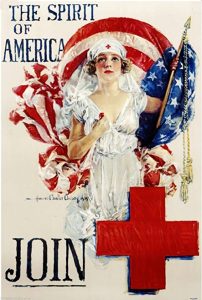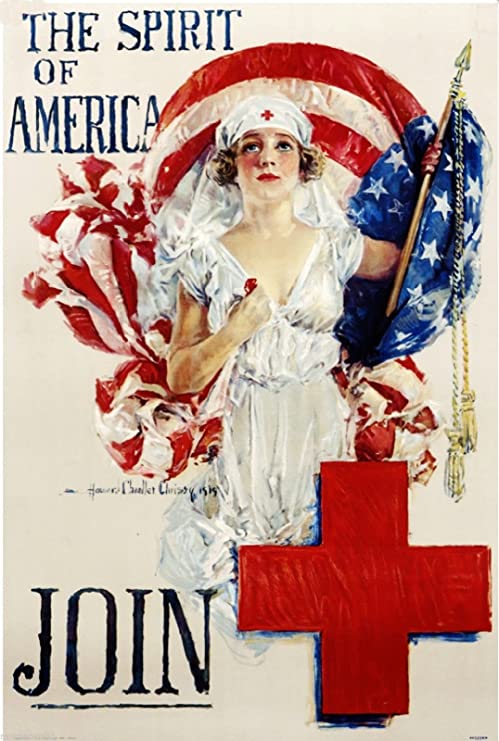
This poster was created in nineteen-nineteen by Howard Chandler Christy, and shows a blonde female who appears to be a citizen of the United States in a nursing gown. Behind her is an American flag and the words on top of the flag read The Spirit of America. Below the lady it shows a red cross and the words “JOIN” next to it. The red cross in the poster symbolizes the Red Cross, or ICRC (International Committee of the Red Cross). The Red Cross during World Wars One and Two was primarily tasked with helping those who had been affected by conflict and armed violence around the world, also promoting the laws that protect the victims of war. To this day, their mission has not changed, with a quote on their website stating, “To protect the lives and dignity of victims of armed conflict and violence and to provide them with assistance”.[1]
After World War One, the United States saw the harsh and ferocity of modern war at the time. They saw how they needed to help those civilians who were affected by the tragedies and bloodshed of war, after the public saw the horror and amount of blood that had been spilt all over the world in such a short amount of time. The Red Cross wanted to grow their organization into a more cohesive, more powerful organization that can help when the next war arises, which would turn out to be World War Two. In nineteen-nineteen, Howard Chandler Christy, a artist and propaganda creator, published the Red Cross poster as described above. This poster was created very specifically for certain people to look at and aspire to. Howard drew this poster meticulously to show the patriotism and beauty that comes out of joining the Red Cross. The way how the woman had blonde hair and is white was done on purpose to appeal to those people who were white, primarily because a blonde white woman in the nineteen-twenties was seen as the perfect woman. The words in the upper-left corner show how the United States is resilient and powerful to take care of others; how America’s “spirit” is aiding others in giving them a better tomorrow. You can see her holding the flag that her left hand is full of blood, symbolizing her heart on the left side of her body and the blood, sweat and tears she has put in the Red Cross in making people’s lives better. In her right hand, she is holding a part of the ripped up American flag behind her, also symbolizing how no matter how torn apart our country is from war or other countries, the Red Cross is still there to help those in need around the world.
This doesn’t come without hardship though, as women in the military and Red Cross had been looked down upon since the idea of women doing other jobs rather than being housewives has come up. But regardless, they still did their job and aided both sides in the conflict. As Julia Irwin puts it in her article:
“On September 12, 1914, a ship carrying 33 surgeons, 137 nurses, and many tons of medical, surgical, and hospital supplies departed the United States for Europe. Upon arrival, these medical teams provided their services to both Allied and Central Powers nations, including Austria, Belgium, England, France, Germany, Serbia, and Russia. Over the next few months, the members of these hospital units treated thousands of patients…”.[2]
This poster is a symbol of that intuition; to help those who needed it in the bloodiest conflict of the time. The Red Cross knew to bring women into the conflict’s workforce, and to bring more women out of the house and into roles where they were needed and wanted.
The Red Cross was primarily filled with women in the early twentieth century, but as were black females also, even though they were still considered at the time “less than” people. As Matilda Saines puts it in her article:
“In the 1910s, trained Black female nurses nevertheless faced steep obstacles. Most Whites and some Black men, according to Hine, viewed them through a “triple index of inferiority”: as nurses, women, and Black. In 1916, the American Nurses Association began requiring membership in a state nursing association. Associations in 16 states and the District of Columbia excluded Black nurses, effectively barring them from membership in the American Nurses Association”.[3]
Even though black women were still marginalized were inferior to others, they still joined the Red Cross solely to help others, and that is what this poster is trying to convey. This poster shows a time of great need to heal the world after a catastrophic war, and the power and spirit of the country.
Bibliography
“Who We Are.” International Committee of the Red Cross, August 11, 2016. https://www.icrc.org/en/who-we-are.
This website helps establish how the Red Cross was important during World War One and how the poster relates to their mission.
Jones, Marian Moser, and Matilda Saines. 2019. “The Eighteen of 1918–1919: Black Nurses and the Great Flu Pandemic in the United States.” American Journal of Public Health 109 (6): 877–84. doi:10.2105/AJPH.2019.305003.
This publication helps support what the picture I am writing about and the importance of it. This also shows the segregation that continued even when everything was in shambles.
Irwin, Julia. 2017. “The American Red Cross in Great War-Era Europe, 1914-1922.” Tocqueville Review — La Revue Tocqueville 38 (2): 117–31. doi:10.3138/ttr.38.2.117.
This publication helps establish how the nurses and the Red Cross helped and were needed during World War One.
[1] Who We Are.” International Committee of the Red Cross, August 11, 2016. https://www.icrc.org/en/who-we-are.
[2] Irwin, Julia. 2017. “The American Red Cross in Great War-Era Europe, 1914-1922.” Tocqueville Review — La Revue Tocqueville 38 (2): 117–31. doi:10.3138/ttr.38.2.117.
[3] Jones, Marian Moser, and Matilda Saines. 2019. “The Eighteen of 1918–1919: Black Nurses and the Great Flu Pandemic in the United States.” American Journal of Public Health 109 (6): 877–84. doi:10.2105/AJPH.2019.305003.
